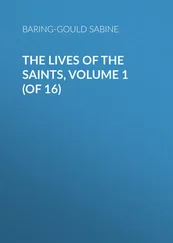Sabine Baring-Gould - The Lives of the Saints, Volume II (of 16) - February
Здесь есть возможность читать онлайн «Sabine Baring-Gould - The Lives of the Saints, Volume II (of 16) - February» — ознакомительный отрывок электронной книги совершенно бесплатно, а после прочтения отрывка купить полную версию. В некоторых случаях можно слушать аудио, скачать через торрент в формате fb2 и присутствует краткое содержание. Жанр: foreign_antique, foreign_prose, на английском языке. Описание произведения, (предисловие) а так же отзывы посетителей доступны на портале библиотеки ЛибКат.
- Название:The Lives of the Saints, Volume II (of 16): February
- Автор:
- Жанр:
- Год:неизвестен
- ISBN:нет данных
- Рейтинг книги:4 / 5. Голосов: 1
-
Избранное:Добавить в избранное
- Отзывы:
-
Ваша оценка:
- 80
- 1
- 2
- 3
- 4
- 5
The Lives of the Saints, Volume II (of 16): February: краткое содержание, описание и аннотация
Предлагаем к чтению аннотацию, описание, краткое содержание или предисловие (зависит от того, что написал сам автор книги «The Lives of the Saints, Volume II (of 16): February»). Если вы не нашли необходимую информацию о книге — напишите в комментариях, мы постараемся отыскать её.
The Lives of the Saints, Volume II (of 16): February — читать онлайн ознакомительный отрывок
Ниже представлен текст книги, разбитый по страницам. Система сохранения места последней прочитанной страницы, позволяет с удобством читать онлайн бесплатно книгу «The Lives of the Saints, Volume II (of 16): February», без необходимости каждый раз заново искать на чём Вы остановились. Поставьте закладку, и сможете в любой момент перейти на страницу, на которой закончили чтение.
Интервал:
Закладка:
Darlugdach, as has been related in the life of S. Bridget, besought her spiritual mother to let her die with her, but S. Bridget promised that she should follow on the anniversary of her departure, after the expiration of a year. And so it was.
[French Martyrologies. Authority: – A life by an anonymous author of uncertain date, but apparently trustworthy.]
S. Severus was the child of very poor Christian parents, who hired him to a nobleman named Corbecan, a heathen, who employed him in tending his herd of mares. The boy loved to pasture the horses in the neighbourhood of a little church dedicated to S. Martin, on the excuse that the herbage there was richer than elsewhere, but really out of love for the House of God. Unable to bear the sight of the misery of the poor, during a cold winter, the boy gave them the clothes off his back, and returned one day through the snow to his master's castle, stripped of everything save his breeches. Corbecan, in a rage, drove him out of the house, and forbade him to shelter in it that night. The lad went to the horses, and crouched among them, taking warmth from their breath. His gentleness and piety, in the end, produced such an impression on Corbecan, that he placed himself under instruction in the faith, and was baptized, he and his whole house. Severus afterwards retired into a solitary place, and lived as an hermit, till a number of disciples gathering round him, he was ordained priest. Against his will he was dragged from his beloved retreat to be consecrated bishop of Avranches. He ruled that see for several years with great zeal and discretion, till the burden became intolerable, and he besought the people to elect a successor. Then he laid down his staff, and retired once more to his forest cell, where he became the master of the blessed Giles. The day of his death is uncertain. His body was translated to the cathedral of Rouen.
In art he is represented with the mares of his master.
[French Martyrology. Authorities: – His life by Sigebert of Gemblours, d. 1112, and mention by Gregory of Tours, and Flodoard.]
This royal saint was the son of Dagobert I., King of France. The father for a long time refused to have his son baptized, but at length by the advice of S. Ouen and S. Eligius, then laymen in his court, he recalled S. Amand, bishop of Maestricht, whom he had banished for reproving his vices, and bade him baptize his son Sigebert. The young prince's education was entrusted to Pepin, mayor of the palace, who carried his charge into Aquitain, to his estates. But at the age of three, Sigebert was invested by his father with the kingdom of Austrasia, or Eastern France, including Provence, Switzerland, Bavaria, Swabia, Thuringia, Franconia, the Rhenish Palatinate, Alsace, Trèves, Lorraine, Champagne, Upper Picardy, and Auvergne.
Dagobert died in 638, and was succeeded by Clovis II., in the kingdom of Western France. Pepin of Landen, was mayor of the palace to Sigebert, and strove to train the young king in godliness and Christian virtues. By his justice and temperance, S. Sigebert rendered himself in his youth greatly beloved and respected by his subjects.
Pepin dying in 640, the king appointed Grimoald, mayor of the palace, in his father's room. The Thuringians revolting, Sigebert reduced them to their duty; and this is the only war in which he was engaged. His munificence in founding churches and monasteries, his justice in ruling, and the private virtues of his spotless life, made him to be regarded as a model of a saintly king. After a reign of eighteen years from the date of his father's death, he died at the age of twenty-five, and was buried in the abbey of S. Martin, near Metz, which he had built. His body was found incorrupt in 1063, and in 1170 it was enshrined in a silver case. When Charles V. laid siege to Metz, Francis of Lorraine, Duke of Guise, demolished all the monasteries and other buildings in the suburbs which could give harbour to the enemy, amongst others that of S. Martin. The relics of the saintly king were then removed to the collegiate church of Our Lady, at Nancy, where they repose in a magnificent shrine.
[His festival is observed as a double by the Church of S. Malo, in Brittany. His name is inserted in Saussaye's supplement to the Gallican Martyrology. Authorities: – The letters of S. Bernard and Nicolas of Clairvaux.]
The illustrious prelate S. John, commonly called "Of the Grate," because of an iron grating which surrounded his sepulchre, was a Breton, the son of parents in a middle class of life. He was born about the year 1098; and from an early age gave indications of piety. In the schools to which he was sent, in a short time he made rapid progress. Peter, abbot of Celle, speaking of him, calls him "the holy bishop, faithful servant of God, a man of courage, loving poverty, a brilliant light, dissipating the densest darkness." His life, as a bishop, was spent in a series of lawsuits with the monks of Marmoutiers. His episcopal seat was at Aleth on the main land, but he desired to transfer it to the island of Aaron, now called S. Malo, on account of the peril to which Aleth was exposed through pirates, and the intestine wars which devastated Brittany. He claimed the island as belonging to the episcopal property of Aleth, but was opposed by the monks of Marmoutiers, who claimed the Church of S. Malo. The case was referred to the Pope, who ordered a commission of French bishops to try the case, and they decided against John. He considered that his cause had been prejudged by them, and visited Rome to carry his appeal in person to the Pope. But Lucius II. would not listen to him, and he was condemned to lose his see. He then retired under the protection of S. Bernard, to Clairvaux, till, on the decease of Lucius II., a monk of Clairvaux was elevated to the papal throne, under the title of Eugenius III. John at once appealed again, and was heard; a fresh commission was appointed, and he was restored to all his rights, and the monks of Marmoutiers were obliged to cede the Church of S. Malo to the bishop. John obtained decisions conformable to that of Eugenius III., from his successors, Anastasius IV. and Adrian IV. That the claim of John was reasonable appears certain. Only three years before he made it, the inhabitants of Aleth had been obliged to take refuge in the island of Aaron to escape the ravages of the Normans, who had already twice pillaged and burnt the city; and it is certain that several of the predecessors of John of the Grate had borne the title of bishop of S. Malo, as well as of Aleth.
During his reign a strange heresy broke out. Eon de l'Etoile, a fanatic, took to himself the title of "Judge of the quick and dead," and armed with a forked stick, shared with God the empire of the universe. When he turned upwards the two prongs of his stick, he gave to the Almighty the government of two-thirds of the world, and when he turned the prongs downwards, he assumed them as his own. This poor visionary was followed by a number of peasants who pillaged churches, and committed all sorts of disorders. They were condemned, in 1148, by the Council of Rheims, and were reduced to submission by the temporal power. John exerted himself, by persuasion and instruction, to disabuse of their heresy such of the fanatics as over-ran his diocese, and succeeded in converting many of his wandering sheep.
He died in the odour of sanctity on Feb. 1st, 1163, and was buried on the Gospel side of the altar in the Church of S. Malo. His reputation for virtue was so well established, that almost immediately he received popular reverence as a Saint. Numerous miracles augmented the devotion of the people. In 1517, one of his successors, Denis Brigonnet, ambassador of the king to Rome, obtained from Pope Leo X. permission for him to be commemorated in a solemn office, as a confessor bishop. This was the year in which began the schism of Luther.
Читать дальшеИнтервал:
Закладка:
Похожие книги на «The Lives of the Saints, Volume II (of 16): February»
Представляем Вашему вниманию похожие книги на «The Lives of the Saints, Volume II (of 16): February» списком для выбора. Мы отобрали схожую по названию и смыслу литературу в надежде предоставить читателям больше вариантов отыскать новые, интересные, ещё непрочитанные произведения.
Обсуждение, отзывы о книге «The Lives of the Saints, Volume II (of 16): February» и просто собственные мнения читателей. Оставьте ваши комментарии, напишите, что Вы думаете о произведении, его смысле или главных героях. Укажите что конкретно понравилось, а что нет, и почему Вы так считаете.












